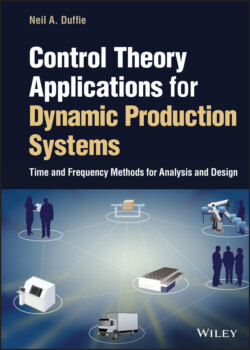Читать книгу Control Theory Applications for Dynamic Production Systems - Neil A. Duffie - Страница 16
2 Continuous-Time and Discrete-Time Modeling of Production Systems
ОглавлениеThe dynamic behavior of a production system is the result of the combined dynamic behavior of its components including the decision-making components that implement decision rules. Production system behavior is not simply the sum of component behaviors, and it only can be understood and modeled by considering the structure of the production system, the nature of interconnections between individual components, and dynamic behavior that results from these interactions. In this chapter, methods for control theoretical modeling of the dynamic behavior of production systems are introduced, both for continuous-time and discrete-time production systems and their components. Then, in subsequent chapters, methods will be introduced that can be used to combine models of production system components and design control components and decision rules that result in desired production system dynamic behavior.
A control theoretical dynamic model of a production system or component is, in the continuous-time case, a set of differential and algebraic equations or, in the discrete-time1 case, a set of difference and algebraic equations that describe how the time-varying outputs of the production system or component are related to its time-varying inputs. The mathematical methods that will be introduced in subsequent chapters are valid for linear models, and development of these models is the focus of this chapter. Because many production system components have behavior that is at least to some extent nonlinear, linearization of models around operating points and linearization using piecewise approximation are described. Some important dynamic attributes of models of production systems and components are introduced including delay, integration, and time constants.
Steps in control theoretical modeling of a production system and its components can be summarized as follows:
Make appropriate assumptions: The level of detail with which production systems and their components can be modeled is limited by practical and theoretical considerations. Aggregated models may, for example, focus on the flow of orders through a production system. The amount of work that has been done may be represented, but not the handling and processing of individual orders. This can facilitate understanding of fundamental behavior, which may be important in the initial design of a production system and its decision-making components. There is a tradeoff: a complex model often can make it difficult to recognize and design fundamental dynamic behavior, but the fidelity of a model is directly affected by the assumptions and simplifications that have been made.
Understand the physics of the production system and its components: Mathematical relationships need to be found that describe input–output relationships in a production system (production process, machine, work system, factory, production network, etc.) and its components. Inputs, outputs, and internal variables need to be identified. Fundamental principles (logistical, mechanical, electrical, chemical, thermal, etc.) or experiments can be used to obtain these relationships.
Linearize relationships if necessary: The models that are obtained must be linear to enable subsequent analysis using control theoretical methods. Linearization is often performed using selected operating points, and care must be taken in using the linearized models that are obtained: they are relatively accurate when variables are in the vicinity of the operating points and are relatively inaccurate when variables deviate from the operating points.
Develop linear algebraic equations and differential or difference equations: These equations can be transformed using methods described in Chapter 3 to facilitate combining models of components into a model of an entire production system and selecting and designing control actions that are implemented in decision-making components.
Simplify the model: Often, the fundamental dynamic behavior of a production system can be adequately described by a subset of the mathematical elements in a dynamic model that has been obtained. For example, it may be possible to eliminate insignificant time delays to reduce complexity. Again, there is a tradeoff: even though relatively complex models can be handled both theoretically and by control system engineering software, relatively simple models often provide better insight for guiding the design of control components and their decision rules.
Verify model fidelity and modify if necessary: A model that has been obtained should be thoroughly examined to ensure that it adequately represents the important aspects of the dynamic behavior of the production system. Both numerical and physical experiments can be helpful in comparing modeled behavior to actual behavior. Model linearization and simplification may adversely affect the fidelity of the model outside a given range of some variables or at smaller time scales. The model may need to be improved to enable successful subsequent use in design of decision-making and prediction of resulting system dynamic behavior.
The model obtained is highly dependent on the physical and logistical nature of the production system and the components being modeled. The utility of the model is highly dependent on the nature of the analyses that subsequently will be performed and the decision-making components that are to be designed as a result. For this reason, past experience in modeling, analysis and design plays a significant role in anticipating the model that is required. Furthermore, models usually need to be modified during subsequent steps of analysis and design: additional features may need to be added, additional simplifications may need to be made, and fidelity may need to be improved. Additionally, the nature of the decisions that are made in production systems, as well as the structure of the information and communication that is required to support decision-making may change as the result of understanding gained during analysis and design; this can require further model modification.
